Recent Arrow releases, part one
Continuing my increasing tendency to report on my viewing company by company, it’s time to look at recent releases from Arrow. Some of these are new to me, others upgrades from older DVD editions.
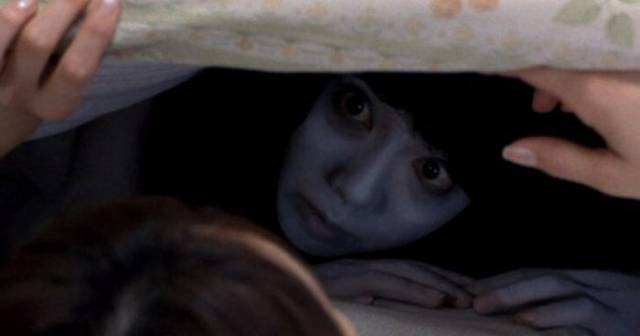
Ju-On: The Grudge Collection (Takashi Shimizu et al., 2000-2009)
I started renting and buying DVDs in 2001 and by chance quickly came across my first few J-horror experiences. According to my notes, these were now long-forgotten movies like Toshiharu Ikeda’s Evil Dead Trap (1988) and Kai Fujiwara’s Organ (1996) – I still have the Synapse DVD of the latter, though I’ve never re-watched it. I gradually came across titles that were less graphic but had a more unsettling atmosphere which appealed to me – Higuchinsky’s Uzumaki (2000), Masato Harada’s Inugami (2001), Norio Tsuruta’s Kakashi (also 2001). In 2002 I bought import copies of Hideo Nakata’s Ringu (1998) and Ringu 2 (1999) and Norio Tsuruta’s Ringu 0 (2000) and was introduced to the vengeful Japanese spirit Sadako.
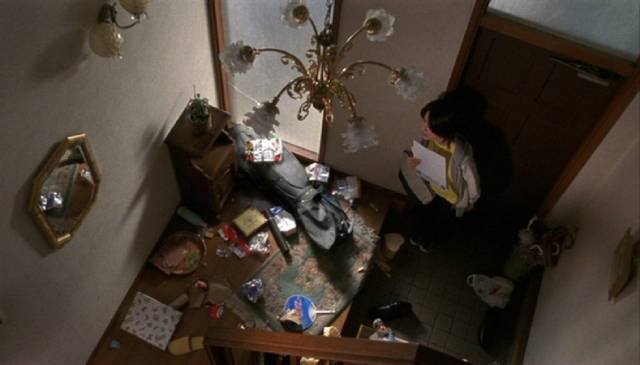
But my love of J-horror was really cemented in 2003 when I acquired DVDs of Takashi Shimizu’s original direct-to-video (V-horror) diptych Ju-On: The Curse 1 and 2, shot back-to-back in only nine days and released just a month apart in early 2000. I honestly can’t think of any other movie which has creeped me out as much as this pair (maybe Jennifer Kemp’s The Babadook [2014]?) and I may be responsible for having scarred the childhoods of quite a few kids because when I took the DVDs over to my friend Steve’s one evening, his daughters watched with us – I can still remember his eldest covering her eyes as the very corporeal ghost crawls down the stairs, then immediately asking us to go back and run the sequence again so she could actually watch it. Then the girls, having borrowed the disks, introduced their friends, thus spreading the J-horror curse among the neighbourhood junior high kids.
The success of those original video releases enabled Shimizu to remake Ju-On as a pair of theatrical features in 2002 and 2003 as Ju-On: The Grudge 1 and 2 and then, remarkably, remake them again with American stars in 2004 (The Grudge) and 2006 (The Grudge 2). I can’t think of any other filmmaker who has returned so obsessively to his material in such a short span of time. And yet, despite increased budgets, longer shooting schedules and time to rethink that material, for me those original V-horror versions are the most effective, and even after two decades and repeated encounters their power to unsettle me remains undiminished.
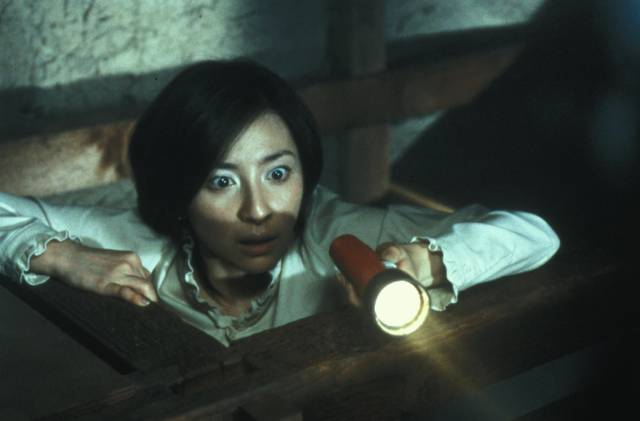
Which is why it was a no-brainer when Arrow announced their five-disk box set, which includes the video pair, the first two theatrical features and the later video pair by different directors, Ju-On: White Ghost and Ju-On: Black Ghost (2009). I assume the absence of the two English-language features is due to rights issues – a pity, as a “complete collection” would have been nice.
Why these movies have such an impact is not entirely clear, as there have been so many malevolent, long-haired Japanese ghosts who behave in similar ways. Shimizu was obviously influenced by Sadako emerging from the television set in the original Ringu … and it would only be a few years before Sion Sono mocked the well-established trope in Ekusute (Exte: Hair Extensions, 2007), indicating how overused such imagery had quickly become. And yet, watching Shimizu’s movies again, their impact remains just as disturbing as I remembered.
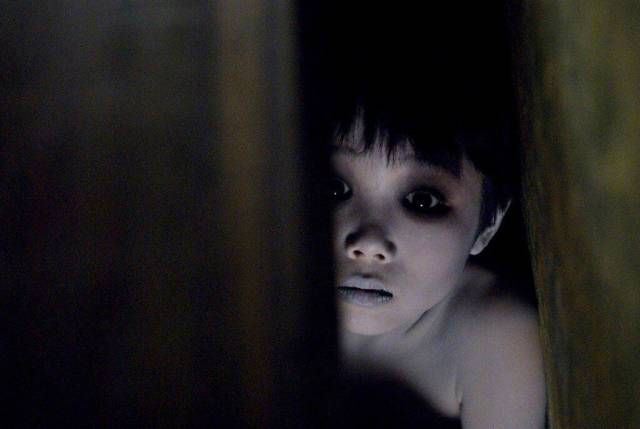
Part of this is simply due to his skill with camera and editing, combined with the physical performance of Takako Fuji as the angry ghost Kayako in all six instalments of the story. But part of it is also due to the way in which Shimizu tells the story in each film as a non-linear collection of interlocking episodes which, though I’ve seen them a number of times, I never quite seem to be able to sort out with complete clarity. Without being able to connect the episodes into a coherent whole which follows a discernible cause-and-effect narrative line, the threat posed by Kayako and her ghostly son Toshio (Ryota Koyama in the V-horror version, Yuya Ozeki in the theatrical pair) remains unresolved, hanging over the viewer long after the movies have ended.
The premise of the films is that when a person dies a violent death, the intense emotions felt by the victim trap her/him in the place where the crime occurred and the lingering pain and anger are transmitted to anyone who comes within range of the ghost’s influence. Here, that victim is Kayako, the wife of Takeo Saeki (Takashi Matsuyama), who butchers her viciously because he believes she’s been unfaithful. He subsequently seems to commit suicide and their young son Toshio vanishes, his fate unknown. Unlike his mother, Toshio isn’t tied to the unexceptional suburban house where the murder occurred; at times he shows up in other places to spook people who have been tainted with the curse.
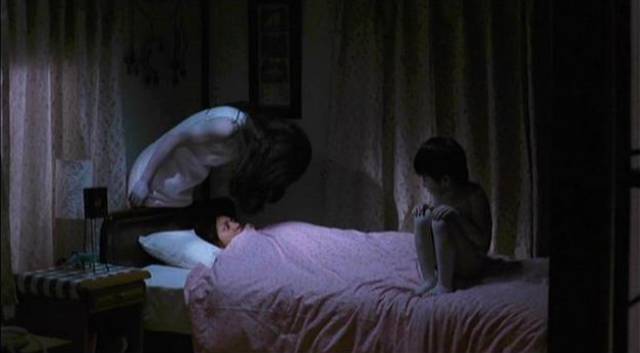
As mentioned, I’m not entirely sure how the timeline works (or whether it really does work in a coherent way). In the first episode, teacher Shunsuke (Yurei Yanagi) pays a home visit to check up on a student who hasn’t been to school in a while. He finds Toshio alone, silent and bruised, and decides to wait for his parents to return. There’s something weird about the boy, who draws disturbing pictures and, when not being observed, makes strange cat-like noises.
And meanwhile, Saeki has paid a visit to Shunsuke’s apartment where he has killed the teacher’s pregnant wife and taken the fetus, phoning his own home to speak to Shunsuke from a blood-spattered phone booth. As Shunsuke panics and tries to get Toshio out of the house, Kayako emerges from the attic and crawls down the stairs with freaky, disjointed movements.
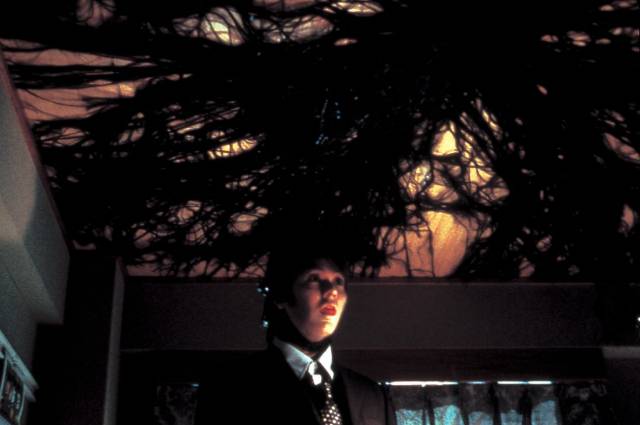
There are six separate episodes, each named for the main character, each centred on an encounter with Kayako’s monstrous anger or Toshio’s strange displacement, seemingly caught somewhere between this world and the spirit realm. Those who are terrorized either die or go mad, spreading the anger in ripples that radiate from that quite ordinary house, and in the second film also from Shunsuke’s apartment.
The pattern is repeated in the second film with other characters – a social worker, a policeman and his daughter (with the latter, time seems to fold in on itself, with the cop seeing his daughter’s future older self endangered in Kayako’s house). The budgetary and schedule limitations are evident here as the first half hour of the second film is essentially the last half hour of the first, with some minor editing changes. I must admit that this was a bit disappointing the first time I watched them – they could both have been edited together into one movie running ninety or a hundred minutes, instead of split into two seventy-odd minute short features – but the individual elements are so effective that I no longer mind the repetition, and the second film expands the effect of the curse beyond that first half hour, justifying itself as a separate work.
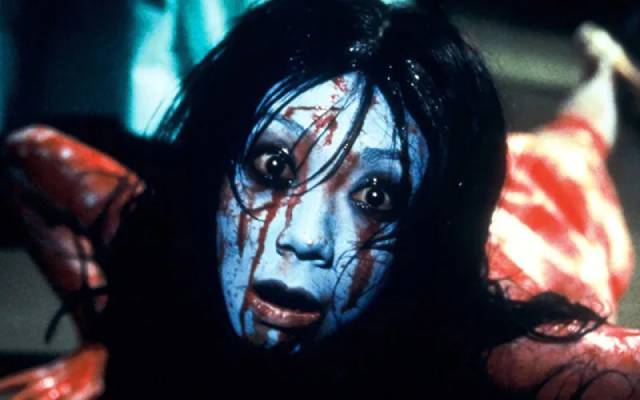
The theatrical features naturally enlarge the scale of the episodes, though this is not necessarily to say that they improve on the originals. Shimizu repeats so many key moments that even though some are expanded and elaborated on it’s almost impossible at times not to feel that he’s just going through the motions – while there are still effective sequences and the unsettling atmosphere is present, the sense of discovery, of something never seen before has inevitably dissipated. The features lack the freshness and surprise of the V-horror films. It’s akin to hearing a comedian retell a joke: the structure is the same, the punchline is there, but the sense of discovery is absent. I’ll always prefer the originals; that sense of discovery is actually aided by the limitations of the production, giving them a taut precision which seems to slacken with the increased resources of the two theatrical films.
After the theatrical versions and the subsequent English-language movies, Black Ghost and White Ghost return to the smaller V-horror realm. These variations-on-a-theme short films (each just an hour) are effectively atmospheric as two other filmmakers get to play in Shimizu’s distinctive nightmare world. In Ryuta Miyake’s White Ghost, another family moves into the Saeki house and find themselves engulfed by the lingering rage. Mari Asato’s Black Ghost ventures a bit further afield, with the rage awakening a teenage girl’s vestigial twin, which begins to grow inside her and take over her body. While neither film breaks much new ground, both create a creepy atmosphere reminiscent of Shimizu’s work.
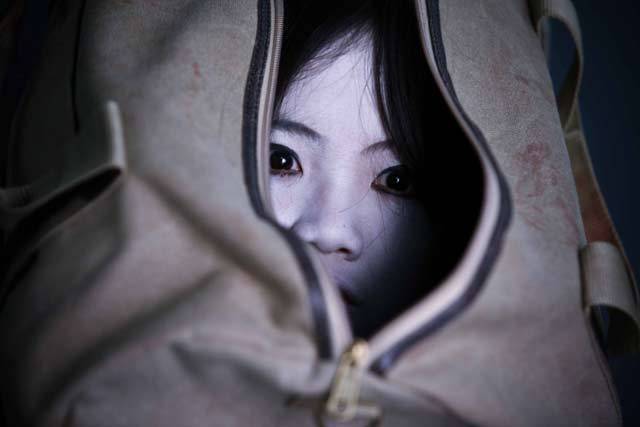
Because of the technical limitations of the V-cinema films – they were shot on standard definition video and share a disk mastered from the original tapes – the image on Blu-ray isn’t very strong, with muted colour and an overall softness. The first theatrical feature gets a 4K restoration, presented on both 4K UHD and Blu-ray disks, while the second feature has an HD transfer on Blu-ray only. White Ghost and Black Ghost were shot on hi-def video and sourced from the original tapes.
The majority of the set’s extras are on the theatrical feature disks, with commentaries, deleted scenes, on-set footage and multiple new and archival interviews. The V-horror movies get extremely brief introductions from Shimizu and actress Takako Fuji, while Black Ghost has a brief introduction and short interview with director Mari Asato, the only female filmmaker involved in the series. There’s also a 60-page book with new and archival writing about the films.
*
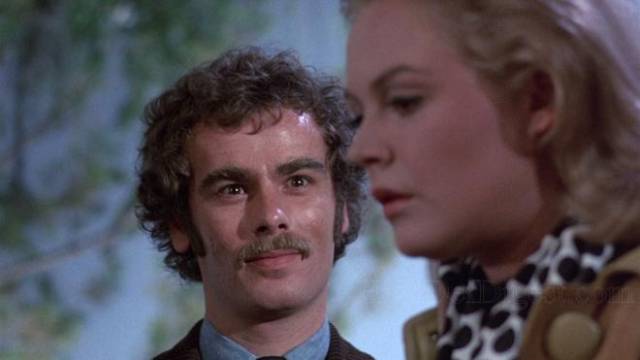
The Dunwich Horror (Daniel Haller, 1969)
In comparison with Ju-On, Daniel Haller’s The Dunwich Horror (1969) is comfortably old-fashioned. Produced by American International, it was the company’s third attempt to adapt the work of H.P. Lovecraft, after Roger Corman’s The Haunted Palace (1963), based on The Case of Charles Dexter Ward (written in 1927 and published posthumously), but attributed to Edgar Allen Poe in order to connect it to Corman’s other Poe movies, and Haller’s own first feature Die, Monster, Die! (1965), based on the 1927 story The Colour Out of Space. Haller had been Corman’s art director on many of the Poe pictures, but left behind the period trappings in his Lovecraft movies. Although there are still Gothic elements, they’re updated to the present day, which particularly in The Dunwich Horror results in some incongruous imagery – dream sequences populated with hippie cultists indulging in orgies, for instance.
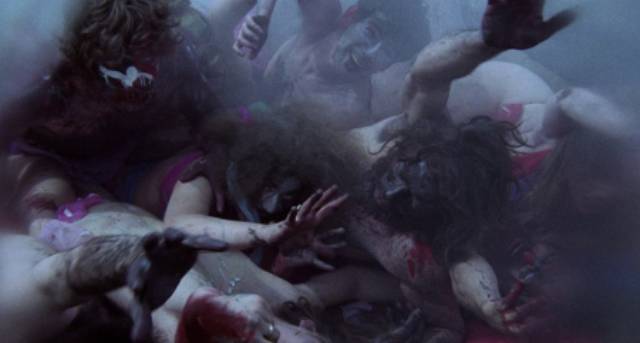
Co-written by future director Curtis Hanson, The Dunwich Horror manages to remain somewhat faithful to Lovecraft. Wilbur (Dean Stockwell), scion of the Whateley family in New England, is determined to re-open a portal to another dimension so that the Great Old Ones can return to Earth and destroy the human race. His reasons for such an apocalyptic ambition lie in his own origins as the hybrid son of a human woman, Lavinia Whateley (Joanne Moore Jordan), and Yog Sothoth himself. In order to carry out his plan, he needs a couple of things – the only known copy of the Necronomicon, currently on display in the library of Miskatonic University, where its owner Dr. Henry Armitage (Ed Begley) is lecturing; and a virgin, whom he finds in the form of student Nancy Wagner (Sandra Dee).
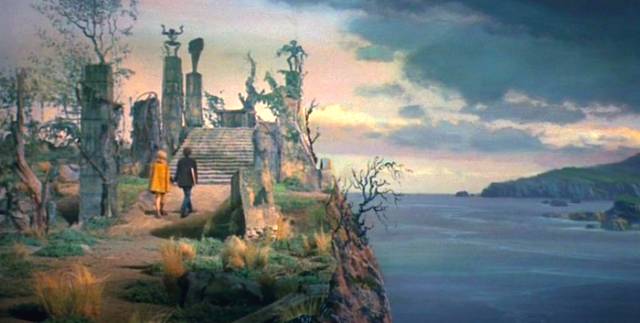
He steals the book and tricks Nancy into accompanying him to the decaying family home he shares with his grandfather (Sam Jaffe), where he uses his charismatic influence and some drugs to suppress her will. When Dr. Armitage and Nancy’s friend Elizabeth come looking for her, we learn the Whateley family history – great grandfather lynched by the townsfolk, and Lavinia giving birth to twins, Wilbur and a mysterious brother who’s locked away in an attic. Elizabeth unwisely goes poking around in the old house and falls pray to the brother, a wild abstract form of flashing lights and flailing tentacles who, unlike Wilbur, took after his father.
Up on a cliff overlooking the sea, Wilbur places Nancy on an ancient stone altar, propping the Necronomicon in her crotch and chanting a ritual invocation to Yog Sothoth. As the portal begins to open, the monstrous brother escapes and sweeps across the countryside, visible only as flashing lights and wind as it kills a number of people along the way. As the ritual reaches its climax, it’s not clear whether the alien creature appearing above the altar is the brother or Yog Sothoth himself … but as the swirling, tentacled creature materializes, Dr. Armitage and local physician Dr. Cory (Lloyd Bochner) arrive in the nick of time to chant a counter-spell and close the portal again.
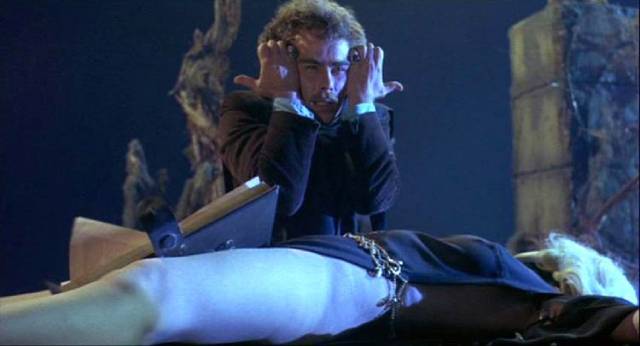
Within the conventions of 1960s horror, The Dunwich Horror is effective and entertaining, though there are incongruous elements like those dreams of counterculture orgies and the unexpected casting of Sandra Dee, best known as Gidget and Tammy. Still looking soft and girlish, it’s strange to see her in the overtly erotic occult ceremony towards the end of the movie – while the very scantily clad Nancy lying on the altar and being groped by Wilbur is very obviously a body double, the wider shots are intercut with medium closeups of Dee’s face, sweaty and moaning rather disconcertingly.
Stockwell plays Wilbur with conviction, a potent mix of charm and menace, while the supporting cast – Begley, Bochner, Jordan, Jaffe, Talia Shire as Dr. Cory’s nurse, Corman regulars Barboura Morris and Beach Dickerson as superstitious townsfolk – add texture and weight to the fantasy.
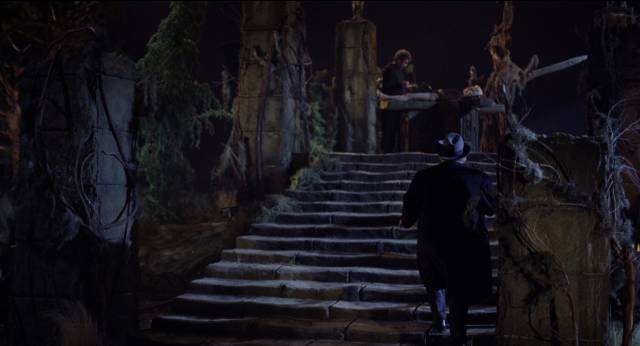
Arrow’s 2K restoration from the original negative is a slight improvement over the out-of-print Scream Factory Blu-ray (on a double-feature disk with Gordon Hessler’s Murders in the Rue Morgue); extras include a commentary, a short interview with author Ruthanna Emrys about Lovecraft’s mythos, a longer piece with music expert David Huckvale about composer Les Baxter and his somewhat experimental score, and a lively conversation between writers Stephen R. Bissette and Stephen Laws over Zoom in which they talk about Lovecraft, their love of The Dunwich Horror (which they both saw quite young) and various other tangential subjects; this is consistently engaging even at a mammoth 130 minutes.
*
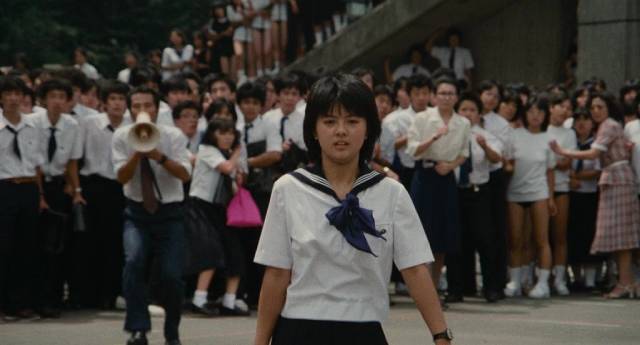
Sailor Suit and Machine Gun (Shinji Somai, 1981)
Despite my love of Japanese cinema in many of its manifestations – Ishiro Honda’s monsters, Kinji Fukasaku’s gangsters, Kiyoshi Kurosawa’s unsettling psychological horrors, Kore-Eda Hirokazu’s mysterious dramas, the wide ranging contemporary and period dramas of Mikio Naruse, Kenji Mizoguchi, Yasujiro Ozu, Akira Kurosawa, not to mention Hayao Miyazaki and many other masters of anime – there are obviously still areas completely unknown to me. Case in point, Shinji Somai, a filmmaker who apparently had a big influence on other directors though his own movies remained largely undistributed in the West.
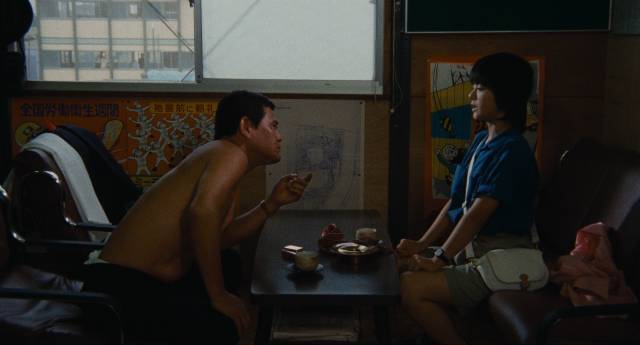
Somai made only thirteen features in twenty years before dying at age fifty-three in 2001. It’s probably not surprising that the first of his movies to be given a prominent English-friendly release on Blu-ray is his second feature, Sailor Suit and Machine Gun (1981), as it ticks off some familiar genre boxes – eroticized schoolgirls and gangsters. But it doesn’t go where a western viewer might expect. The subject seems to call for parody or even absurdist comedy, but Somai treats the material with deadpan seriousness.
When the head of a minor yakuza family dies and his natural successor, a nephew, is killed simultaneously in a car crash, the line of succession falls on an adolescent schoolgirl named Izumi (Hiroko Yakushimaru) and the gangsters show up at her school to take her away and install her as the new boss. Bound by traditions of loyalty, they are committed to serving her. The absurdity of the situation gradually transforms Izumi, whose antisocial tendencies are reshaped by her new role. The handful of loyal yakuza initially assume that the family will be dissolved, but Izumi begins to assert herself and they are unified under her leadership, though this renews conflicts with more powerful families who can only see her as a young girl, not to be taken seriously.
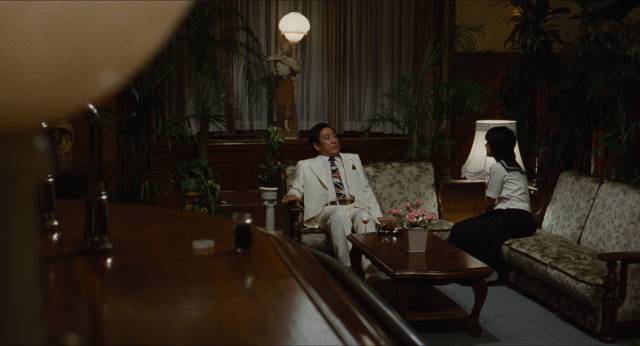
With his elaborate long takes and determination to treat an essentially silly concept with complete seriousness, Somai manages to meld the seemingly incompatible elements into a coherent whole, the inevitable eruptions of violence clashing with Izumi’s naive and undeveloped emotions, her vulnerability in turn triggering protective feelings in her loyal men. It’s fascinating to see how Somai manages to invest this material with emotional authenticity, aided greatly by a cast which plays it all straight. Sixteen-year-old pop star Yakushimaru manages to bridge the transitional gap between immature girlishness and incipient adulthood with apparent ease, while Tsunehiko Watase is completely convincing as a hardened yakuza who gives his unwavering loyalty to this girl because tradition has made her his boss.
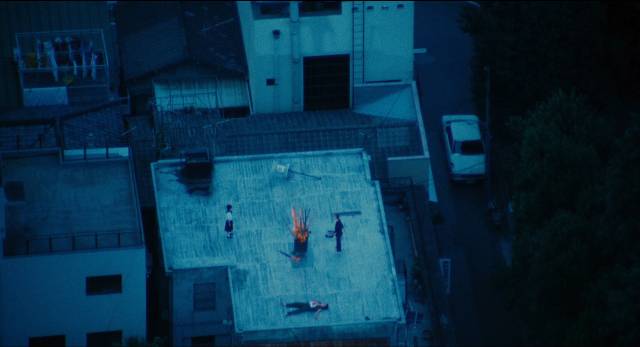
All of this works so well, with its shifting tones, because of Somai’s technique which is rooted in uninterrupted long takes rather than the typical jittery fragmentation seen in so many yakuza movies, frequently with remarkably elaborate choreographed camera moves which somehow manage to conceal their own complexity. He has the ability to create a coherent dramatic space which makes the most absurd narrative developments completely plausible.
The 4K transfer from the negative is a little drab, though this seems to reflect the quality of the original photography. A new fifty-minute documentary focuses on Somai and his influence on other filmmakers and the cultural moment out of which the film came, conceived as a commercial vehicle for the popular singer Yakushimaru.
To be continued …
Comments
I have the Americanized Grudge movies as well as the Japanese White Ghost and Black Ghost films in my collection.
I’m also a fan of the Japanese horror movies from the 50’s and 60’s. Onibaba, Kwaidan and Kuronkeo come to mind. The last two titles I have on Criterion blu-ray.
Vengeful ghosts seem to be the main element of Japanese horror. Very interesting reviews as always Kenneth.
But now I need to track down Sailor Suit and Machine Gun! That’s one of the benefits of reading your reviews… you always come up with an interesting title I need to add to my collection 🙂